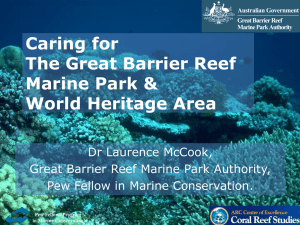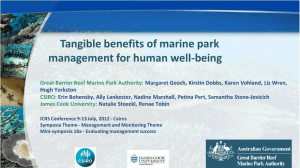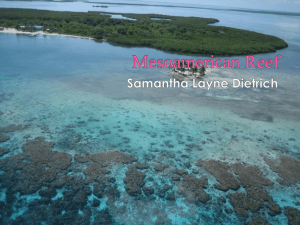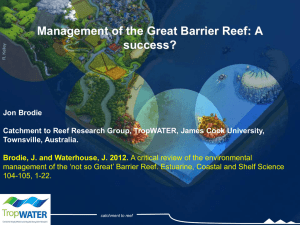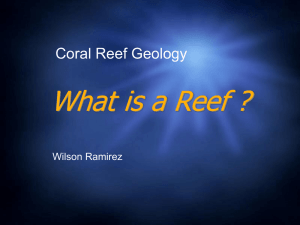Reef 2050 Long-term Sustainability Plan Fact Sheet
advertisement
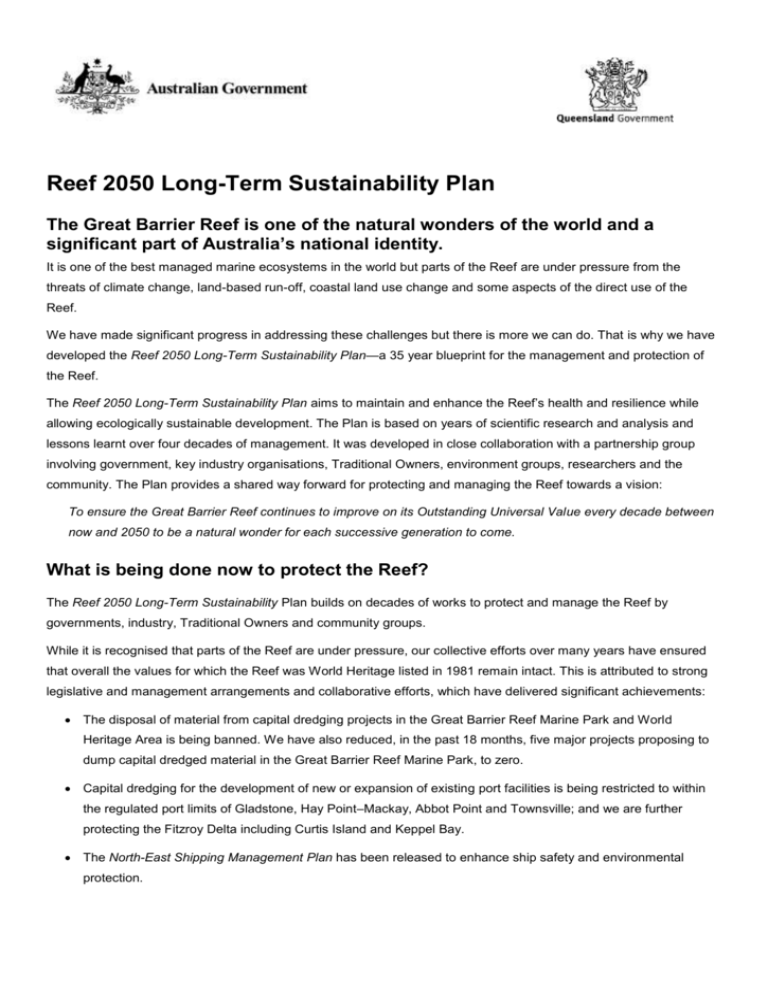
Reef 2050 Long-Term Sustainability Plan The Great Barrier Reef is one of the natural wonders of the world and a significant part of Australia’s national identity. It is one of the best managed marine ecosystems in the world but parts of the Reef are under pressure from the threats of climate change, land-based run-off, coastal land use change and some aspects of the direct use of the Reef. We have made significant progress in addressing these challenges but there is more we can do. That is why we have developed the Reef 2050 Long-Term Sustainability Plan—a 35 year blueprint for the management and protection of the Reef. The Reef 2050 Long-Term Sustainability Plan aims to maintain and enhance the Reef’s health and resilience while allowing ecologically sustainable development. The Plan is based on years of scientific research and analysis and lessons learnt over four decades of management. It was developed in close collaboration with a partnership group involving government, key industry organisations, Traditional Owners, environment groups, researchers and the community. The Plan provides a shared way forward for protecting and managing the Reef towards a vision: To ensure the Great Barrier Reef continues to improve on its Outstanding Universal Value every decade between now and 2050 to be a natural wonder for each successive generation to come. What is being done now to protect the Reef? The Reef 2050 Long-Term Sustainability Plan builds on decades of works to protect and manage the Reef by governments, industry, Traditional Owners and community groups. While it is recognised that parts of the Reef are under pressure, our collective efforts over many years have ensured that overall the values for which the Reef was World Heritage listed in 1981 remain intact. This is attributed to strong legislative and management arrangements and collaborative efforts, which have delivered significant achievements: The disposal of material from capital dredging projects in the Great Barrier Reef Marine Park and World Heritage Area is being banned. We have also reduced, in the past 18 months, five major projects proposing to dump capital dredged material in the Great Barrier Reef Marine Park, to zero. Capital dredging for the development of new or expansion of existing port facilities is being restricted to within the regulated port limits of Gladstone, Hay Point–Mackay, Abbot Point and Townsville; and we are further protecting the Fitzroy Delta including Curtis Island and Keppel Bay. The North-East Shipping Management Plan has been released to enhance ship safety and environmental protection. The decline in water quality entering the Reef from agriculture has been halted and reversed. Pesticide load has been reduced by 28 per cent, sediment load by 11 per cent, total nitrogen load by 10 per cent, and dissolved inorganic nitrogen by 16 per cent compared to a 2009 baseline. But we can and will go much further. Crown-of-thorns control funding has been doubled. The breakthrough with the one-shot injection for crown-ofthorns star fish has been extraordinary and has received worldwide attention, and as we go forward there will be additional support for crown-of-thorns starfish management. Extra protection has been provided for turtles and dugongs through tough new laws against poaching, improved sustainability agreements with Indigenous communities and local land managers and funding to help reduce marine debris. Three independent reviews of Gladstone Harbour has been conducted and the Gladstone Healthy Harbour Partnership has been created, bringing together 25 partners from community, government, industry and research to monitor and where necessary improve the health of the harbour. Climate change is being tackled through national direct action and international engagement. Australia has a strong domestic policy through our $2.55 billion Emissions Reduction Fund and we are contributing internationally to meet our agreed targets. Australia is committed to reducing its emissions to five per cent below 2000 levels by 2020—this represents a reduction of 19 per cent from business-as-usual levels. Australia has more than met its target for the first commitment period of the Kyoto protocol. The Australian and Queensland governments have either completed, or are implementing, all of the World Heritage Committee recommendations about protection and management of the Great Barrier Reef, and in many cases have exceeded its expectations. What does the Plan do? The Plan recognises that the Reef is large and complex—an area the size of Italy—a place where there always has been and always will be economic activity; uses that are and must be ecologically sustainable. The Plan draws together for the first time all the work, expertise and science critical to managing the Reef for the next three decades and beyond. It sets clear targets and objectives and outlines the actions we will need to undertake over the next five years to start us on the Plan’s journey. Very importantly, it brings together all the key players—governments, Traditional Owners, industry, environment groups and the community—who can collectively give life to the Plan’s vision to secure the Reef’s future. It will build the health and resilience of the Reef to help strengthen its ability to cope with the biggest threat to coral reefs the world over—climate change. It builds on Australia’s strong domestic policy and our efforts internationally to meet our agreed emissions reduction targets. The Plan outlines ambitious targets and actions across seven key areas—biodiversity, ecosystem health, water quality, heritage, community benefits, economic benefits and governance—which include: tightening controls on port development in the World Heritage Area banning the disposal of dredge material across the entire World Heritage Area protecting greenfield areas by restricting new port development in and adjoining the Great Barrier Reef World Heritage Area to within current port limits. These port limits are long-established and fixed in regulations under the Transport Infrastructure Act 1994 (Qld). 2 further reducing sediment, nitrogen and pesticides running into the Reef lagoon working with land managers to put in place accredited best management farm practices building the capacity for local government and industry to improve water quality management in urban areas strengthening engagement with Traditional Owners in the management of the Great Barrier Reef improving the ecological sustainability of fishing in the Reef, including reviewing the regulatory structure of fishing, establishing new net-free zones and enhancing compliance with regulations building on existing safeguards for shipping management, including a focus on pilotage requirements and consideration of a new vessel class and strengthening port control inspections strengthening protection of natural wetlands and riparian vegetation. How is science informing our action? Science is at the heart of our efforts to manage and protect the Reef. The more we learn about the Reef through our research, the better equipped we are to ensure it remains healthy for future generations. All Reef policy and programs, from the development of the Reef Trust though to every day management, are supported by science. This critical information comes from a wide range of sources—research institutions, government agencies, universities, commercial companies and consultants, stakeholders, traditional owners and the community. The Reef 2050 Long-Term Sustainability Plan responds to the findings in the Great Barrier Reef Marine Park Authority’s scientifically robust Outlook Report 2014, which has been adopted by the International Union for Conservation of Nature as the model for the management and reporting globally of World Heritage natural properties. Future Outlook reports will continue to inform our work. Outlook Report 2014 followed a two-year strategic assessment of the Reef. Both pieces of work have vastly improved our understanding of the challenges facing the Reef and how to tackle them. How will the Plan be funded? Investment over the coming decade for research and management activities on the Reef and in the adjoining catchments along the coast is projected to be more than $2 billion. Implementation of the Plan will be underpinned by an investment framework which will identify investments in protecting the Reef, determine investment priorities for the future, and set out a strategy for boosting investment and diversifying its sources. Governing and implementing the Plan The Australian Government, the Great Barrier Reef Marine Park Authority and the Queensland Government will lead implementation of the Plan. The Great Barrier Reef Ministerial Forum comprising ministers from the Australian and Queensland governments will oversee the Plan’s implementation, reporting annually on progress. The Plan will be a schedule to the Great Barrier Reef Intergovernmental Agreement signed by the Prime Minister of Australia and the Queensland Premier. A Reef advisory committee will facilitate engagement with industry and the broader community and an independent expert panel will provide expert advice on implementing and reviewing the Plan. 3 Five yearly revisions, the first due in 2020, will be informed by the 2019 Outlook Report. The Plan’s outcomes, targets, actions and priorities will adapt as our scientific understanding and knowledge improves and we have more evidence about the effectiveness of interventions and investments by government. © Commonwealth of Australia, 2015. This fact sheet is licensed by Commonwealth of Australia under a Creative Commons Attribution 4.0 Australia licence. The views and opinions expressed in this publication are those of the authors and do not necessarily reflect those of the Australian Government or the Minister for the Environment. 4


